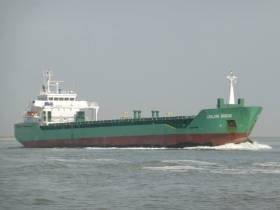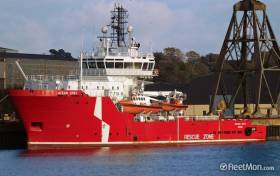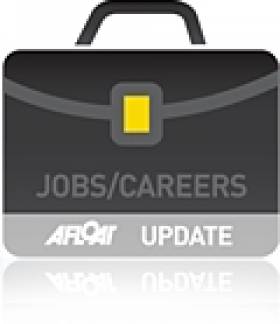Displaying items by tag: Mainport Group
Suction Sail Assisted Cargo Ship Calls to Port of Cork Sees Same Technology Benefit Airbus On Board Ro-Ro Across the Atlantic
Dock operatives of Ronayne Shipping, part of Irish Mainport Holdings, were discharging fertilizer in the Port of Cork recently from a short-sea cargo ship that had distinctive towers mounted at the stern, writes Jehan Ashmore.
The 2,850-dwt vessel, Eems Traveller, of Amasus Shipping B.V. based in Delfzijl, had berthed alongside the city’s north central quays, where onlookers observed the two large white towers.
Senior personnel of the Mainport Group met the vessel’s Captain Anton, who explained that the (rigid eSAILs®) towers are each 18 meters in height, weigh 25 tons, and were designed by the Spanish company Bound4Blue.
The units are known as sucking sails, and have similar technology to the wings of an airplane. Each sail has a large-capacity electric fan atop it, responsible for sucking in the air to ensure the airflow remains attached to the sail.
With ideal wind direction, the sails can save up to 9% in fuel usage and achieve 1.5 knots for the almost 91-metre dry-cargo ship built in 2000.
In addition, there are the benefits of decarbonisation, which has taken place since the installation of the automated wind-assisted propulsion systems in July last year.
Airbus On Board and Suction Sails Aloft
The rigid sail technology specialist, with its headquarters based in Barcelona, just last month, had the same system for the French operator, Louis Dreyfus Armateurs (LDA) Group, installed on their 5,400 dwt ro-ro Ville de Bordeaux. In this case, using three slightly higher eSAILs® of 22m each on the 2004-built vessel, which is chartered by subsidiary LD Seaplane to the major multinational aircraft manufacturer, Airbus.
This has set a new milestone for Bound4Blue as it marks the first-ever fixed suction sail installation on a ro-ro ship with a top-tier European shipowner. LDA had a ferry subsidiary, LD Lines, which operated a Rosslare-Le Havre route, their first Ireland-France route, but ceased when, in 2011, they sub-chartered the Norman Voyager to Irish-based Celtic Link Ferries, which ran the ropax also out of the Wexford ferryport but instead to neighbouring Cherbourg.
Celtic Link Ferries (see story) Ireland-France route was acquired by Stena Line a decade ago. As for the LD Seaplane's ro-ro Ville de Bordeaux, which last month departed a shipyard in Vigo, Spain, from where its brand-new suction sail system was installed following foundation deck works in Poland last year. The technology on board could potentially save up to 1,800 tons of CO2 emissions annually.
On this date a month ago, Ville de Bordeaux departed Saint Nazaire (Montoir-de-Bretagne) France (on its maiden voyage with the eSAILs®) bound for Mobile, Alabama, USA, based on a voyage of approximately two weeks with a call via Belfast Harbour.
The Ville de Bordeaux is designed to transport A320 family components from Europe for final assembly at the aircraft manufacturer’s US factory in Mobile. Afloat today tracked the vessel in France, following its return to Montoir, exactly a month after departing for the US north central Gulf coast port.
In 2014, LD Lines launched the first ever passenger /freight ferry route linking Ireland and Spain through Gijón, with an en route port of call of Saint Nazaire (also Montoir) in western France.
In addition the company operated UK-Spain links and those on the English Channel, including Louis Dreyfus Transmanche Ferries (LDTF) use of twin yellow-hulled ferries on the Newhaven-Dieppe link, but LDTF's contract concluded in 2007.
The classic former UK-France railway operated route linking London-Paris, dating to the early 19th century, is currently operated by Danish ferry firm, DFDS on behalf of a local public authority (SMPAT) and continues to be branded as Transmanche Ferries.
Another French operator, Brittany Ferries, today Afloat highlights, celebrates its 20th year of flagship service by Pont-Aven on the Cork-Roscoff route, having made its inaugural France-Ireland round trip on the 2,3 and 4 April, 2004.
Shipping Snippets: Ardmore Tanker Calls to Bantry, Arklow Disposes Cargoship & Mainport Chase Vessel Departs Cork Dockyard
#ShippingSnippets - A 183m tanker from Ardmore Shipping Corporation based in Bermuda which also has a principle operating office located in Cork, made a call to Bantry Bay recently, writes Jehan Ashmore.
Ardmore Seaventure which at 49,999 dwt is on of the largest of the 27 strong fleet had anchored at the single point mooring (SPM) system at the Whiddy Island oil terminal. The ship had sailed from Ventspils, Latvia and has since headed to west Scotland. Until yesterday, the tanker had taken anchorage in Brodrick Bay, Isle of Arran (see 'Superyacht' posting).
Bantry Bay Terminals is operated by Zenith Energy, where the facility is also capable of handling VLCC’s and 30-meter draft vessels for the discharging of petroleum cargoes and other products.
Another short-sea trader from Arklow Shipping Nederland B.V., Arklow Bridge is no longer part of the Dutch division fleet. The 4,723gt vessel only built in 2011, is one of a pair of original 'B' class ships. The other sister Arklow Brook remains in service. They differ to a succession of ships from a varient of the 'B' series also built by Bodewes in the Netherlands.
Afloat has tracked down the 116m cargoship which has been renamed Aasvik, when berthed in Szczecin,Poland. Also a change of flag to Gibraltar has taken place.
An earlier 'Brook' had served ASL, having been custom built at Appledore Shipbuilders in 1990 followed by sister 'Bridge' the next year. The yard in Bidna, north Devon is now Babcock Marine & Technology's facility that is currently constructing the Naval Service's fourth OPV90 sister to be named L.E. George Bernard Shaw.
Cork based Mainport Group's seismic chase vessel, Mainport Kells has been at the Cork Dockyard facility. The 350grt vessel of only 37m built almost a decade ago at the Shin Yang yard Malaysia in 2008, had yesterday carried out sea trials beyond the harbour off Roches Point Lighthouse.
Corkonians would of seen Mainport Kells berthed previously at Cork city quays. A fleetmate the seismic survey vessel Mineport Pine remains there along North Custom Quay.
Mainport Group Acquire Supply Support Vessel for Kinsale Gas Field
#MainportKinsale - Afloat first reported of Ocean Spey operating at the Kinsale Gas Field last Wednesday and now it can be confirmed the standby supply support vessel is to be reflagged under the Irish tricolour having been acquired by Mainport Group, writes Jehan Ashmore.
The 1,864 tonnes Ocean Spey had been based at Aberdeen (see photo) the 'oil' capital of Scotland until she sailed six weeks ago to Cork Harbour, homeport of the Mainport Group.
The 66m long Ocean Spey has yet to be given a customary company ‘tree’ suffix themed name i.e. Mainport Cedar (harking back to the Irish Shipping Ltd fleet era). The vessel is currently offshore of the pair of gas rig platforms, Kinsale Alpha and Bravo some 50kms offshore of the Cork coastline.
Ocean Spey is a Norwegian 2000 year built vessel with anchor handling capacity that replaced Mainport’s standby supply ship, Pearl. This 1,579 grt vessel has served the Kinsale Gasfield since 1985.
Mainport provides the newcomer, Ocean Spey to serve at the PSE Kinsale GasField offshore gas installation which has changed hands since gas extraction began in the late 1970’s. A Mainport subsidiary, Seahorse having then begun operations with albeit smaller vessels the Seahorse Minder and Seahorse Supplier.
Some three weeks ago, Pearl was stood down and destored at her usual berth at Ringaskiddy. The 65m vessel then relocated the short distance across Cork Harbour to where the vessel remains alongside Cork Dockyard. There was an interim period when Mainport deployed Celtic Isle of subsidiary Celtic Tugs at the gasfield prior to the introduction of Ocean Spey.
Also recently in Cork Harbour, Mainport Cedar, as previously reported on Afloat back in 2014, was the first of a pair of newbuild Malaysian built seismic-survey vessels delivered to Mainport of the previous year. Notably earlier this year the vessel was detained during a charter for a UN World Food Programme mission to war-torn Yemen.
This was Mainport Cedar's first ever call to Cork Harbour and this was due to maintenance requirements in between sailing from the North Sea and the Gulf of Mexico. The work carried out took place at Cork Dockyard in advance of a contract to a seismic company for the oil sector in the Gulf of Mexico as also featured in last Friday’s Seacapes.
The seismic-survey vessel has since departed Cork Harbour on the North Altantic repositioning voyage.
#UNship - Mainport Cedar, which carried out a UN World Food Program to war-torn Yemen is on her first visit to Cork City where her Irish owners are based, writes Jehan Ashmore.
It was during the 9 month contract to the UN that the seismic support vessel which also is a supply ship carried out the unusual role of making humanitarian transportation voyages. The charter of the ship to the Arab country ceased earlier this year.
Mainport Cedar has accommodation for 50 (10 officers and 40 marine crew) and a 1-bed hospital unit. During its UN charter role, the vessel transported UN personnel to Yemen.
As previously reported the 1,659 gross tonnage ship is the leadship of a pair built in Malaysia as the first purpose built seismic support ships for the Mainport Group. The 2013 built ship is berthed at Cork along Albert Quay, adjacent to the Port of Cork’s City Centre Marina.
The reason for the first call of the 53m vessel is due to the completion of a project in the Bristol Channel.
As for the next project, it would appear that Mainport Cedar is next bound for Nassau, Bahamas, though Mainport declined to confirm that the Caribbean island is the next area of operation.
Operating much closer to home, Mainport have the contract to serve the Kinsale Gas Field. This is carried out by the multi-role support vessel Pearl out of Ringaskiddy, lower Cork Harbour. It was here that Celtic Fergus, the latest acquisition for subsidiary Celtic Tugs was delivered by cargoship earlier this year.
Taoiseach Announces Marine Jobs On Visit of RV Celtic Explorer
An Taoiseach Enda Kenny visited the Marine Institute's research vessel RV Celtic Explorer in Dublin Port today, where he announced the creation of 92 jobs in the marine sector, writes Jehan Ashmore.
"Ireland is now recognised as an emerging power in Marine Research and Innovation," said the Taoiseach. Of the new positions, 64 will be generated in the seafood processing sector. This follows a €3.5m Seafood Processing Business Investment Scheme administered by Bord Iascaigh Mhara (BIM). In the area of marine research, 28 jobs have been created through funding of €2m from an International SmartOcean Graduate Programme.
SmartOcean is a collaboration between IRCSET (Irish Research Council for Science Engineering and Technology), the Marine Institute, five Irish universities and key multinationals and SME Information and Communication Technology (ICT) companies to provide funding for 28 research posts.
The Taoiseach said: "This has been achieved through the mapping of the 90% of Irish national territory that lies under the Atlantic, the creation of a quarter of a billion Euros worth of marine research infrastructure, and the fostering of strong linkages between industry and research centres, all of which will support employment opportunities in key areas of potential growth in the marine sector."
During the tour of the RV Celtic Explorer, the Taoiseach who was accompanied by Minister for Agriculture, Marine and Food, Simon Coveney, welcomed the expansion of Ireland's capabilities in the international shipping services sector, which is expected to attract additional jobs to the country.
Ireland's emerging international shipping services sector has continued to grow, underpinned by a number of investments in new and second hand ships over the last twelve months by such companies as Arklow Shipping and the Mainport Group, as well as foreign direct investments by D'Amico and Ardmore shipping.
As reported on Afloat.ie, RV Celtic Explorer had arrived yesterday into Dublin Port, having completed a fisheries demersal survey which started in Galway on 23 September. Initially she had docked at Ocean Pier but she subsequently shifted berths to Sir John Rogersons Quay for today's reception of An Taoiseach. According to her survey schedule she is due to depart tomorrow on a herring acoustic survey which is to take place in the Celtic Sea and off the south-west coast.
- Dublin Port
- BIM
- Marine Institute
- marine science
- Arklow Shipping Ltd
- Bord Iascaigh Mhara
- Ports and Shipping News
- Ardmore Shipping
- Mainport Group
- D'Amico
- Irish marine jobs
- An Taoiseach Enda Kenny
- SmartOcean
- RV Celtic Explorer
- RV Celtic Voyager
- Sir John Rogersons Quay
- Irish research vessels
- Simon Coveney
On board the 60m vessel there is an aft clear working deck space used for supplies which is capable of handling two 20ft reefer containers and a single 20ft storage container. The vessels' powerplant is provided by 2 x Caterpillar 3516B main-engines of 1920kW (5150bhp) at 1500 rpm which drive twin kort nozzles propellers and equipped with a corresponding pair of high-lift rudders.
Accommodation is for 42 berths (11 for officers and crew) and other marine personnel (numbering 31) in addition to two hospital berths. All of the cabins are air-conditioned with washrooms/WC.
Dina Alliance brings the Mainport Group fleet total to 24 vessels (for list click HERE) which are deployed in various sectors engaged in offshore support vessels covering safety standby, tugs, tanker assist, towage, bunkering and seismic support services.
Earlier this year the company's Foynes based tug Celtic Isle was requested to assist in refloating the stricken combi-heavy lift vessel Pantanel which had dragged its anchor in stormy seas after running aground in Cashla Bay, Rossaveal. The German-owned vessel was to load two former Aran Direct owned fast-ferries that operated from the Connemara harbour on a delivery voyage bound for Mauritius.
Mainport is a Cork based operation with offices located in Foynes, Limerick, Drogheda in addition to operations overseas in Durban and Johannesburg in South Africa and Aktau in Kazakhstan.
- Celtic Tugs
- Ports and Shipping News
- Aran Islands
- Aran Direct
- Rossaveal
- Island News
- North Sea
- Mauritius
- Mainport Group
- Cashla Bay
- Celtic Isle
- Dian Alliance
- Anchor handling tug supply
- AHTS
- Aran Islands fast ferries
- Pantanel
- Combicarrier Pantanel
- Mauritus
- shipgrounding Cashla Bay
- Supply Seismic Support Vessel
- North Sea energy reserves
- Dina Alliance
Vacancies at Mainport International Corporation
The Mainport International Corporation has vacancies for the following positions.
Masters for their Seismic Support Vessels working worldwide. The suitable candidate is required to have good ship-handling experience, as the position involves replenishment of seismic vessels at sea, while underway. Simulation training will be given at the National Maritime College of Ireland (NMCI) Ringaskiddy prior to commencement of employment.
In addition there are vacancies for Engineers on board their Seismic Support Vessels. The position is for a tour of duty of two-months on and two- months off. Applicants are asked to email their CV and relevant certificates to [email protected] and [email protected]
For further information in general about the Cork based Mainport Group logon to www.mainport.ie and for the NMCI www.nmci.ie


































































